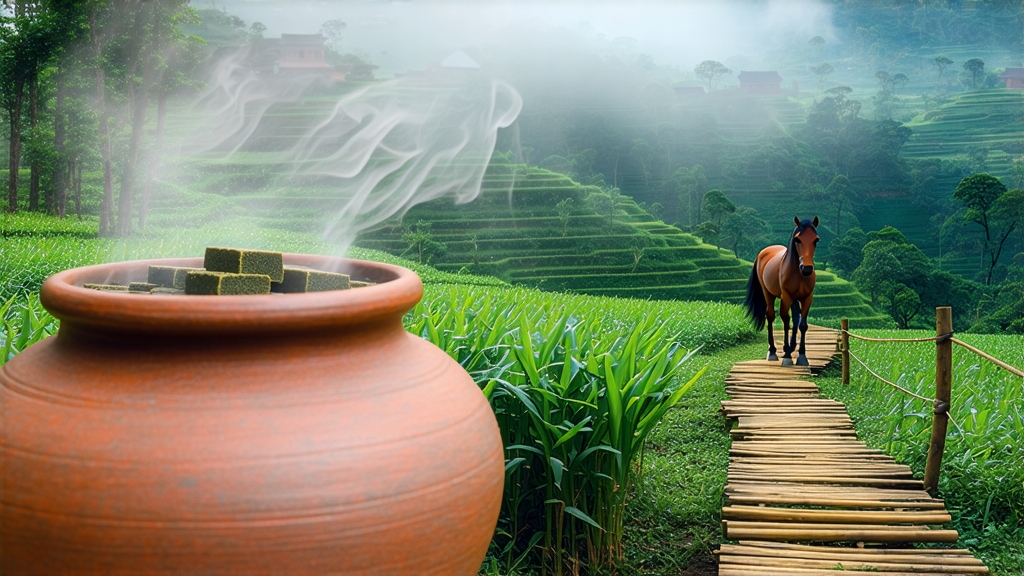
Liu Bao—literally “Six Forts”—is the name of a town, a tea, and a quiet legend tucked into the creased karst hills of southern Guangxi, China. To most Western drinkers, “dark tea” begins and ends with shou Pu-erh, yet Liu Bao is a full century older than the ripened cakes of Yunnan, and its mellow, camphor-betel perfume once perfumed the caravans that supplied the Qing dynasty frontier. This article invites you to walk the humid bamboo corridors of Wuzhou County, to listen for the muffled heartbeat of microbes inside a 30-kilogram basket of fermenting leaves, and to learn why Liu Bao is once again commanding the attention of collectors from Paris to Melbourne.
-
From Military Rations to Maritime Currency
The story begins in the late Ming (1600s), when the imperial court needed a tea that would survive the 3,000-kilometer march to the garrisons of Xinjiang. Sun-dried maocha from Guangxi’s Da Wu Mountains was compressed into bamboo baskets, loaded onto mules, and sent west along the Tea Horse Road. The heat of the tropics, the jostling of hooves, and the night dew conspired to oxidize the leaves far beyond ordinary green tea; by the time the caravan reached the Gobi, the liquor had turned garnet, the flavor had mellowed into sweet bark, and soldiers swore it cured dysentery. When the Qing opened the port of Wuzhou in 1897, Liu Bao became ballast aboard British clippers bound for Singapore and Kuala Lumpur, where tin-mine laborers traded wages for baskets because the tea prevented beriberi in the swampy heat. Thus a frontier ration metamorphosed into an unofficial currency of the South China Sea. -
Terroir: Where Limestone Meets Monsoon
Liu Bao township sits at 23° N, 300 m above sea level, on the Tropic of Cancer. The soil is a purple calcareous clay shot through with crushed oyster fossils—mineral-rich, fast-draining, and slightly alkaline. Daytime temperatures hover at 28 °C with 85 % humidity; at night the karst radiates heat, creating a perpetual sauna that accelerates leaf chemistry. The indigenous cultivar is Camellia sinensis var. sinensis f. pubilimba, a small-leaf bush whose underside is covered in tawny down that traps moisture and aroma compounds. Locals insist that the tea’s signature “betel-nut” note—an intoxicating mix of camphor, nutmeg, and dried longan—originates in the symbiosis between this cultivar and the limestone microflora. -
Craftsmanship: The Living Sequence
Unlike Pu-erh, Liu Bao undergoes a unique double fermentation that predates the 1973 invention of shou puerh’s wo dui. The process is choreographed across an entire lunar calendar:
a. Plucking: Two leaves and a bud around Qingming (early April) when amino acids peak.
b. Solar Withering: Leaves are spread on bamboo screens for 4–6 h until they lose 30 % moisture; the sun’s UV triggers initial non-enzymatic oxidation.
c. Kill-Green: A 3-minute tumble in a 200 °C drum arrests polyphenol oxidase but preserves thermostable aroma precursors.
d. Rolling: A 40-minute knead on a fir-wood board ruptures 60 % of cell walls without macerating the leaf, allowing controlled microbial access later.
e. First Pile Fermentation (wo dui): The semi-dry leaves are heaped 70 cm high, sprayed with mountain spring water (pH 7.2), and covered with jute sacks. Internal temperature climbs to 55 °C within 24 h; thermophilic Bacillus subtilis and Aspergillus niger dominate, converting catechins into theaflavins and gallic acid. Every 48 h the pile is turned; after 15 days the leaf turns chestnut-brown and emits a sweet compost aroma reminiscent of soy sauce lees.
f. Basket Compression: While still 20 % moist, 50 kg of leaf is tamped into cylindrical bamboo baskets lined with wild banana leaf.